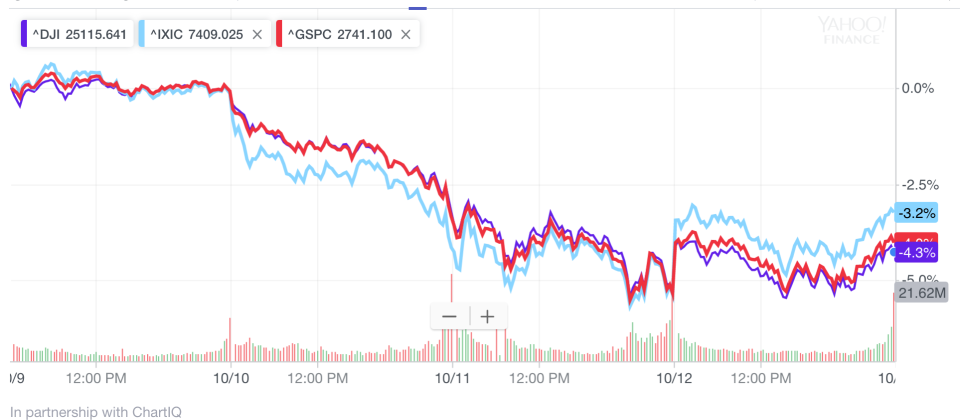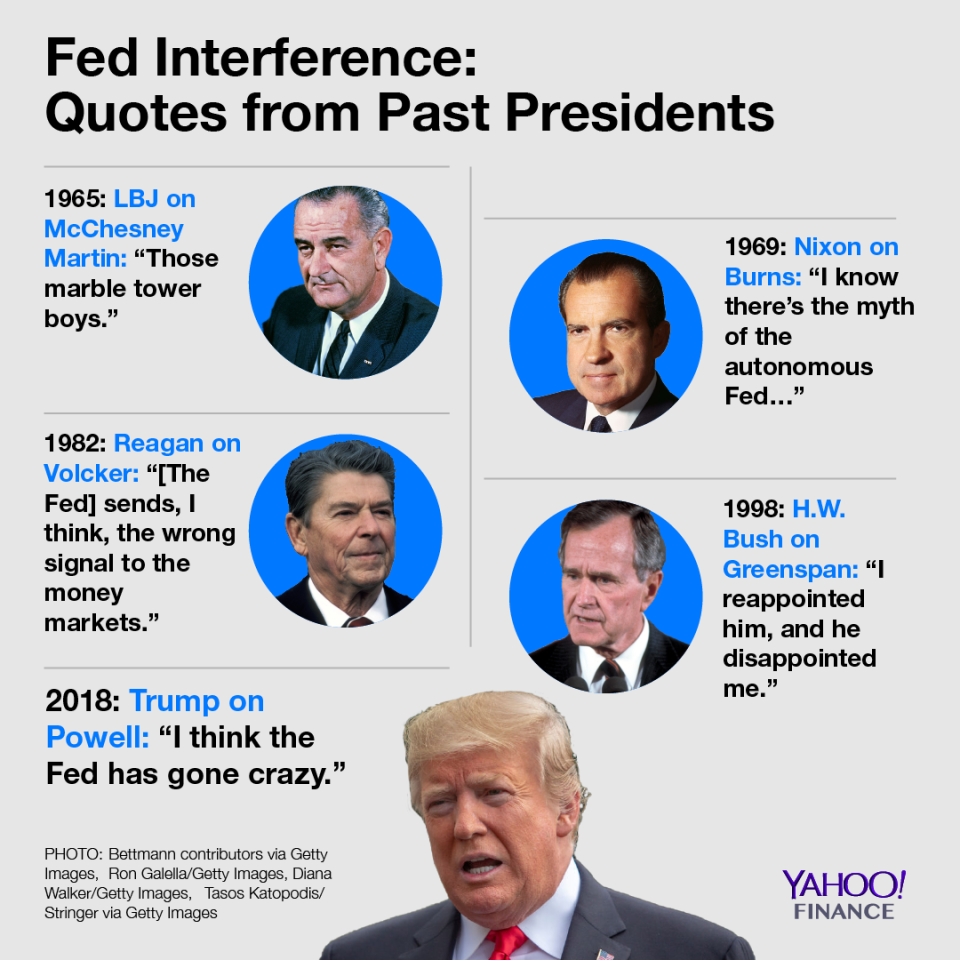Netflix, Goldman, and 50 others report earnings — What you need to know in markets for the week ahead
It was a brutal week for investors.
The major indexes rallied on Friday with the Dow gaining about 1% and the Nasdaq rising more than 2%, but this move didn’t quite heal the week’s scars as each index fell more than 3%.
“After Thursday’s bloodbath, US equities staged a nice rally to close out the week on Friday, even after a number of intraday attempts to push stocks lower,” said analysts at Bespoke Investment Group.
“The buyers finished with the upper hand for now, but bulls are far from out of the woods at this point. Like any major shock to the system, there are nearly always aftershocks that we will have to contend with in the near term.”

On Friday, third quarter earnings season unofficially kicked off with big U.S. banks leading the way as JP Morgan (JPM), Citi (C), Wells Fargo (WFC), and PNC (PNC) all reported results, and the news was generally solid. The market’s volatility to end the week, however, was somewhat independent of any reaction to specific earnings results.
In the week ahead, earnings season will pick up with more than 50 members of the S&P 500 scheduled to report earnings.
Notable reports this week should include Bank of America (BAC) reporting on Monday; Netflix (NFLX), Morgan Stanley (MS), Goldman Sachs (GS), United Airlines (UAL), Johnson & Johnson (JNJ), BlackRock (BLK), and IBM (IBM) reporting on Tuesday; Abbot Labs (ABT) and United Rentals (URI) reporting on Wednesday; American Express (AXP), PayPal (PYPL), Philip Morris (PM), Travelers (TRV), BNY Mellon (BK), Textron (TXT), PPG (PPG), and Danaher (DHR) reporting on Thursday; and Procter & Gamble (PG), Honeywell (HON), Kansas City Southern (KSU), and Schlumberger (SLB) reporting on Friday.
The economic calendar’s highlight will come on Monday when the September report on retail sales is released, which is expected to show a rebound after disappointing in August, with the minutes from the Fed’s latest policy meeting out Wednesday also closely watched.

Economic calendar
Monday: Empire State manufacturing activity, October (20 expected; 19 previously); Retail sales, September (+0.6% expected; +0.1% previously)
Tuesday: Industrial production, September (+0.2% expected; +0.4% previously); Capacity utilization, September (78.2% expected; 78.1% previously); Homebuilder sentiment, October (67 expected; 67 previously); Job openings and labor turnover survey,, August (6.875 million job openings expected; 6.939 million previously)
Wednesday: Housing starts, September (-5.6% expected; +9.2% previously); Building permits, September (+2.1% expected; -5.7% previously); FOMC minutes
Thursday: Philly Fed business outlook, October (20 expected; 22.9 previously); Initial jobless claims, October (210,000 expected; 214,000 previously)
Friday: Existing home sales, September (-0.8% expected; 0% previously)
This is the stock market now
Last week, stocks got crushed.
The Dow and S&P 500 dropped in excess of 3% on Wednesday and another 2% on Thursday. Over those two days, the Dow lost more than 1,300 points. Through Thursday, stocks were looking at their worst start to October since the financial crisis.
In the end, each major index fell more than 3% and for the third time this year we saw the S&P 500 drop 3% in one trading session. The benchmark index experienced no days with drops of this magnitude in either 2016 or 2017.
Why markets dropped so sharply this week remains a matter of debate. And whether or not investors agree on one or any of the causes for the market’s decline, what is not up for debate is that these bouts of volatility are now mainstays of the post-tax cut bull market. Investors need not like that the market will swing violently with little warning, they just need to accept that it will happen.
One possible explanation for this past week’s action is interest rates, with the yield on the 10-year Treasury hitting a seven-year high earlier this month. Rising rates, however, is not a particularly new story for investors this year and an increase in rates — along with the implosion of certain volatility products — was also flagged for triggering the market’s sell-off in February.
A few earnings updates earlier this week may have also raised concerns for investors, as American Airlines (AAL) on Tuesday flagged rising fuel costs as a headwind, PPG (PPG) highlighted almost every macro concern from inflation to trade to China’s economy while cutting its earnings forecast for the rest of this year, and Fastenal (FAST) cited inflation pressures throughout its earnings call.
With markets on the cusp of third quarter earnings season and stocks getting punished for bad news, it’s possible investors are in for a rougher ride than had been previously anticipated when quarterly report cards are released. And as we noted last week, investors are being particularly harsh on companies that miss earnings expectations.
Then there is President Donald Trump, who twice this week expressed his displeasure with the Federal Reserve’s recent decision to raise interest rates and its plans to continue raising rates in the months ahead.
“The Fed is making a mistake,” Trump told reporters Wednesday, according to Reuters’ Jeff Mason. “They’re so tight. I think the Fed has gone crazy. So you could say that, well that’s a lot of safety actually, and it is a lot of safety, and it gives you a lot of margin, but I think the Fed has gone crazy.”
But with Trump now having criticized the Fed on several occasions, it is clear that investors ought to be prepared for continued commentary on monetary policy from the president. As Yahoo Finance’s Brian Cheung noted this week, however, though Trump’s Fed-related comments are a break with recent presidential tradition, he is not the first president to voice their displeasure with the central bank.

Each of these news-related catalysts for triggering a stock decline — rates, inflation, earnings, the Fed — hide that before the selling came in waves on Wednesday, it was clear all was not well below the surface of the stock market. The way this week ended should not change that assessment.
On Tuesday, Ritholtz Wealth Management’s Michael Batnick noted that while the S&P 500 was to that point just about 1.5% off its record high, the average stock in the index was down more than 13%. The index quickly caught up over the following two days. Analysts at Bespoke Investment Group also highlighted on Tuesday that small cap stocks had been under even more pressure, with the average member of the S&P Small Cap 600 down more than 20% through Monday’s trading.
And though these observations were not predictions of tough times to come for markets, the market did show weakness before a complete break. And when the break came, the story was something investors have now seen on three occasions this year.
It is one investors ought to get used to. Because bouts of violent selling leaving investors pointing in a variety of directions for a cause is clearly a feature, not a bug, of the current market environment.
—
Myles Udland is a writer at Yahoo Finance. Follow him on Twitter @MylesUdland
